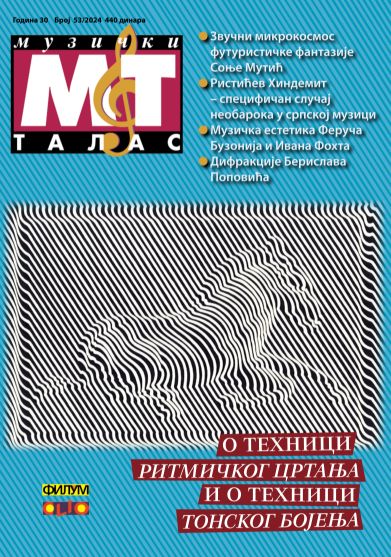РИСТИЋЕВ ХИНДЕМИТ – СПЕЦИФИЧАН СЛУЧАЈ НЕОБАРОКА У СРПСКОЈ МУЗИЦИ
RISTIĆ’S HINDEMITH - A SPECIFIC CASE OF NEOBAROQUE IN SERBIAN MUSIC
Author(s): Miloš BralovićSubject(s): History of Art
Published by: Izdavačko preduzeće CLIO
Keywords: Milan Ristić; manuscrip legacy; Paul Hindemith; subjects and sketches; fugues; Serbian Music Legacy Preservation; Board of the Serbian Academy of Sciences and Arts
Summary/Abstract: This paper is a revision of the chapter about Milan Ristić from the author’s doctoral dissertation titled The Works of the Composers of the Prague Group After World War II in the Context of European Modernist Tendencies, defended at the Faculty of Music, Department of Musicology on 27 April 2023. In the doctoral dissertation we have examined five notebooks with subjects and sketches, alongside his four cycles of fugues, which are kept in the Serbian Music Legacy Preservation Board, within Serbian Academy of Sciences and Arts. During the summer of 2023, the author of this text was appointed as secretary of the Board, with a task to reorder and prepare Milan Ristić’s manuscript legacy for digitalisation. Five notebooks with subjects and sketches were created from 1954 to 1977. During our work we discovered another three notebooks with subjects and sketches, spanning from January 1942 to June 1943. Regarding the fourth cycle of fugues (first three being: Fugues for Chamber Ensemble. Book I, 1950–1951; Six Fugues for Piano, 1952; Four Fugues for String Trio, 1958), in the doctoral dissertation, we used a copy containing only 19 fugues out of 24. The other five fugues were discovered in another collection of notebooks, containing their original manu- script. Thus, the last cycle of fugues contains 24 fugues, and it was composed from 1965 to 1967. Ristić’s main role model, regarding his compositional style, was, as we concluded in the doctoral dissertation, Paul Hindemith. The two composers shared a common trait, and that was the polyphonic composing. Thus, we compared Hindemith’s cycle Ludus tonalis (1943) with Ristić’s last cycle of fugues. However, while Hindemith aspired to create a cycle of densely connected movements, Ristić did not care as much about the organisation of the cycle. Ristić was per- fectioning his composition skill using the Hindemith’s concept of total tonality (tonalität), as explained in his textbook Unterweisung im Tonsatz, 1937, and the last 24 fugues (which he regarded as a preparation for composing the latter works) demonstrate his perfection and flexibility of composing within such system.
Journal: Muzički talas
- Issue Year: 30/2024
- Issue No: 53
- Page Range: 32-45
- Page Count: 14
- Language: Serbian
- Content File-PDF

